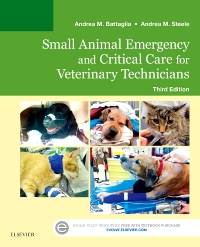
Small Animal Emergency and Critical Care for Veterinary Technicians - Elsevier eBook on VitalSource, 3rd Edition
Elsevier eBook on VitalSource

Prepare veterinary technician students for the care of pets requiring emergency and critical care! Small Animal Emergency and Critical Care for Veterinary Technicians, 3rd Edition provides quick access to dozens of common, life-saving protocols and procedures. Each treatment technique is described in step-by-step detail and illustrated in full color. To reflect the veterinary setting, a team approach is emphasized. This edition adds even more value with two new chapters and practical, easy-to-apply medical math and scenario-based exercises. With even more exercises on the companion website, this practical resource offers students the practice they need to master the VTNE and to succeed in animal hospital emergency departments and veterinary practices.
Newer Edition Available
Small Animal Emergency and Critical Care for Veterinary Technicians - Elsevier eBook on VitalSource
-
- Comprehensive coverage of pain management, respiratory emergencies, and urologic emergencies provides cutting-edge treatment options for a wide variety of commonly seen presenting problems.
- Step-by-step instructions on how to perform specific procedures and techniques help vet techs successfully perform key assessment and treatment techniques.
- NEW! An Evolve companion website includes exercises and scenarios for the additional practice that students need to master the VTNE and find success in emergency and critical care settings.
- NEW! Scenario-based training exercises challenge students to apply what they have learned to real-life emergency situations.
- NEW Emergency Receiving and Client Communication in an Emergency chapters provide students with tools to improve their communication and gain client trust during stressful emergency situations.
- NEW! Separate chapters focus on how to develop critical thinking skills and how to receive an emergency, offering better guidance on how to assess small animal patients in different emergency situations.
- NEW! High-quality, full-color photographs and illustrations accurately depict the clinical signs encountered in emergency and critical care.
- NEW! Medical Math exercises provide students with extra practice to help them improve their math skills.
- NEW! Technician Notes emphasize important, need-to-know information in a concise format.
- Technician Tip boxes highlight specific procedures, with at-a-glance guidelines including diagrams, photos, and detailed instructions.
- UPDATED coverage of equipment and techniques includes the latest information on basic lab equipment, fluid therapy, and oxygen therapy.
- Equipment lists for procedures ensure that vet techs will have the appropriate tools on hand for each type of emergency situation.
- Key terms, chapter outlines, and learning objectives at the beginning of each chapter focus on important content and allow easier lookup of topics.
- The Art of Scheduling chapter offers solutions for managing difficult overnight shift and rotation schedules.
-
- NEW Emergency Receiving and Client Communication in an Emergency chapters provide you with tools to improve your communication and gain client trust during stressful emergency situations.
- NEW! Scenario-based training exercises challenge you to apply what you’ve learned to real-life emergency situations.
- NEW! An Evolve companion website includes medical math exercises and scenarios, offering additional practice to help you prepare for the VTNE and find success in emergency and critical care settings.
- NEW! High-quality, full-color photographs and illustrations accurately depict the clinical signs encountered in emergency and critical care.
- NEW! Technician Notes emphasize important, need-to-know information in a concise format.
- NEW! Medical Math exercises provide extra practice to help you improve your math skills.
-
SECTION 1: Critically Ill Small Animals
1. Critical Thinking Skills
2. Monitoring of the Critically Ill or Injured Patient
3. Patient's Lifeline: Intravenous Catheter
4. Fluid Therapy
5. Transfusion Medicine
6. Nutritional Support for the Critically Ill Patient
7. Oxygen Therapy Techniques
8. Mechanical Ventilation
9. Pain Assessment and Treatment
10. Anesthesia in the Critically Ill or Injured
SECTION II: Emergency Care for Small Animals
11. Isolation Techniques in Clinical Practice
12. Emergency Receiving NEW!
13. Management of Patients in Shock
14. Cardiopulmonary Cerebrovascular Resuscitation
15. Trauma
16. Hematologic Emergencies
17. Cardiovascular Emergencies
18. Respiratory Emergencies
19. Gastrointestinal Emergencies
20. Metabolic and Endocrine Emergencies
21. Urologic Emergencies
22. Reproductive Emergencies
23. Ocular Emergencies
24. Neurologic Emergencies
25. Toxicologic Emergencies
26. Avian and Exotic Emergencies
27. Disaster Medicine
SECTION III: Practice Management
28. The Art of Scheduling
29. Client Communication in an Emergency NEW!


 as described in our
as described in our 